The capital of Catalonia Region on Spain’s northern Mediterranean coast, Barcelona city is an open-air museum with a multitude of fascinating things to see and do. Follow our suggestions for this Barcelona 2 day itinerary and discover how to see the top sites, from the historic quarter down to the fashionable seafront boulevard.
Barcelona is considered one of the ‘coolest’ cities in the world! One of the most visited places in Europe, Barcelona is a popular city break famous for Gaudí’s Sagrada Familia Cathedral and other Catalan modernism wonders, an authentic Gothic Quarter, the seafront promenade, beaches and marinas, a lively nightlife and wonderful Mediterranean cuisine. With a 2-day Barcelona itinerary you can see it all!
How to See the Top Sites in Barcelona – 2 Day Itinerary
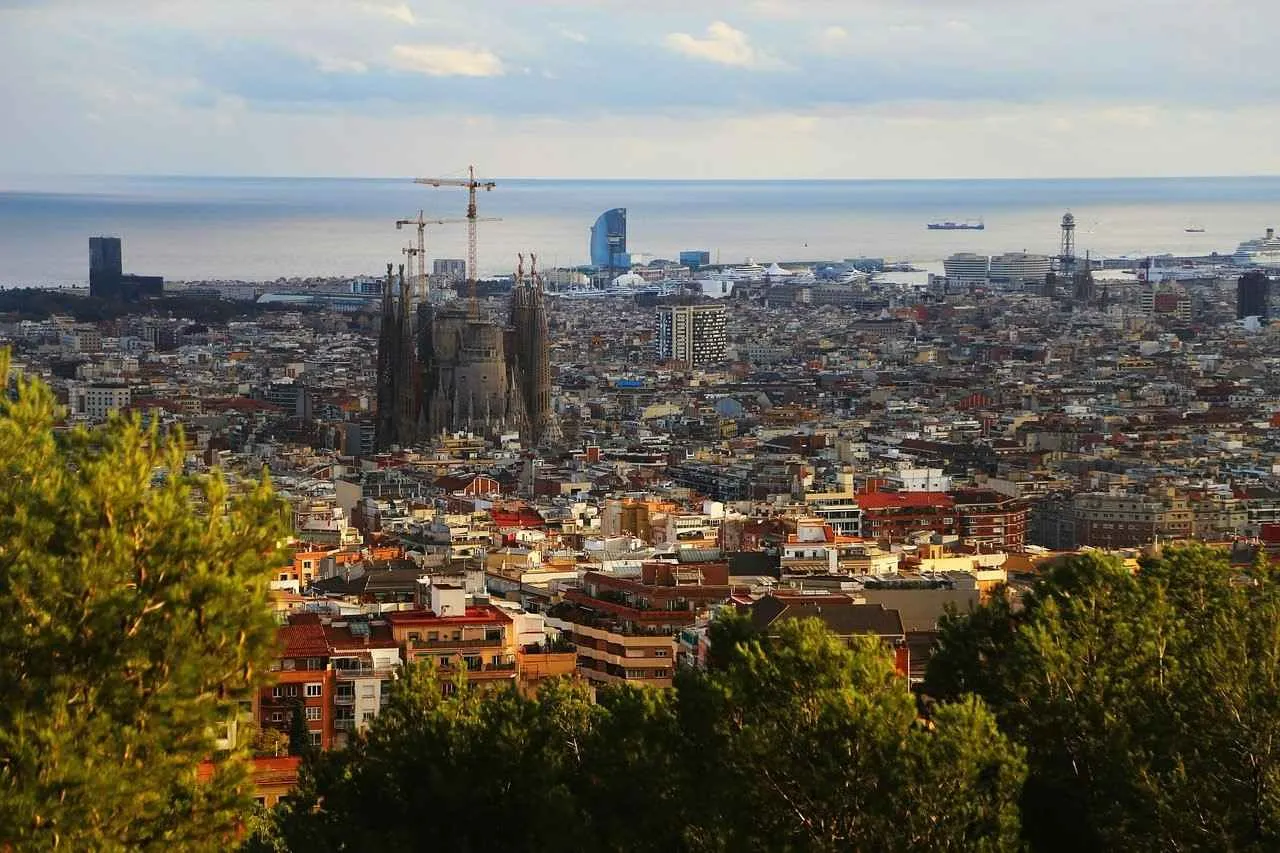
Barcelona Itinerary 1 Day
How to See Barcelona
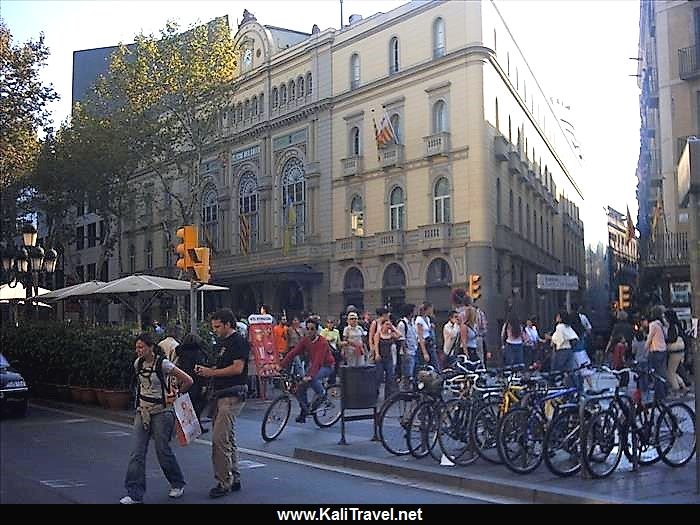
The easiest way to see Barcelona on a 1 or 2 day itinerary is to buy a pass for the Tourist Bus – just hop on and off the open-topped bus where and when it suits you, and as many times as you wish. There are three different routes around the city taking you to see the most interesting historical buildings, monuments, leisure harbours, parks and shopping centres.
Barcelona is bicycle friendly too, so hiring a bike is great way to discover the city and see the sites if you’re spending a couple of days here. The Metro is an economical, time-saving alternative, a two or three-day combined public transport bus/tube/train ticket is ideal – whizz beneath town on the underground system, once again changing as many times as you like.
Top Places to See in Barcelona ‘Old Town’ – La Ciutat Vella
Plaça de Catalunya
Plaza Catalunya is situated in the heart of the old town, this huge square peopled with strollers and street musicians is Barcelona’s nerve centre, and the city’s main thoroughfares radiate from here. Set between the medieval ‘old town’ which unfolds towards to the seafront and the ‘newer’ modernist Eixample district developed in the 1800’s, this is a central point to start a walking tour to see the main sites of Barcelona.

It’s simple to arrive at Plaça de Catalunya, as this landmark public square is a transport hub with many bus stops nearby and the ‘Catalunya’ Metro station, as well as suburban and regional train terminals, are steps away underground below. Wander around the fountains and statues, capture the plaza on film, then begin exploring this beautiful city.
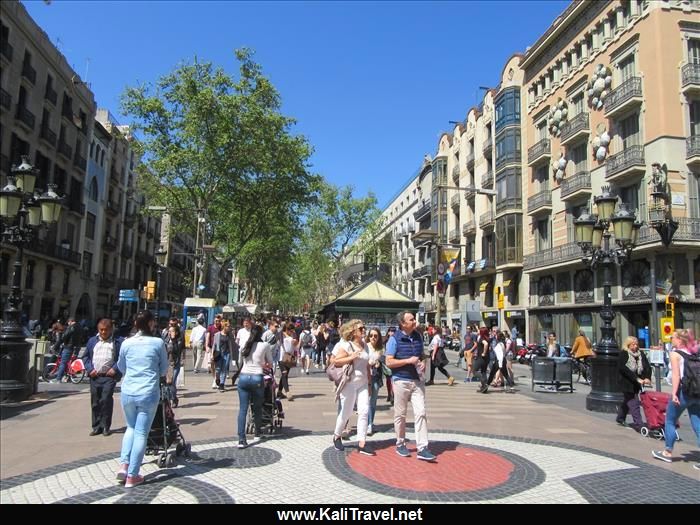
La Rambla
La Rambla is a wide lively boulevard running from Plaça de Catalunya down to Barcelona port, lined with street cafes, newspaper kiosks and book stands, interspersed with bird and flower stalls. Thriving commerce has its focus on the side streets.
1. La Boqueria
The stained glass arched entranceway to Barcelona’s famous foodie market is easy to spot, halfway down La Rambla on the right-hand side.
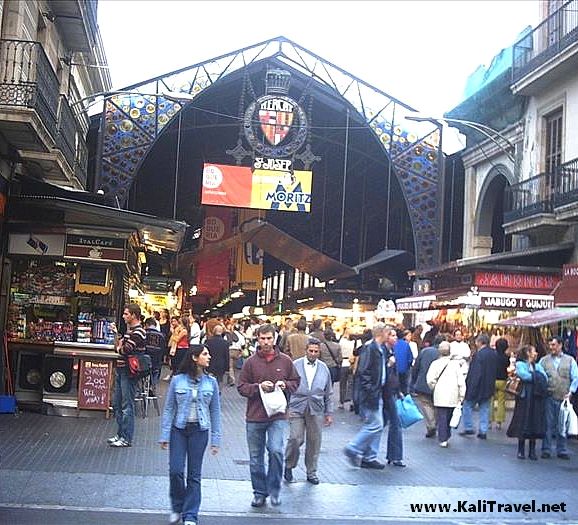
‘La Boqueria’ is a traditional market where locals have apparently shopped for groceries since the 1200s! Started as a livestock marketplace, the stalls of today’s indoor market are set up in the iconic food hall under an original metalwork roof which dates to 1914. Mercat de Sant Josep de la Boqueria has an extraordinary display of Mediterranean vegetables and fruit, meats and fresh fish, as well as dozens of tantalizing eateries. Open everyday from 10am to 11.30pm, it’s liveliest in the mornings.
This is a great place to try some ‘tapas’ aka typical Spanish aperitifs for lunch or stop off for a gastronomic treat. Not surprisingly, ‘tapa tours’ are becoming trendy and there are some good vegan Barcelona food tours organised in the city too.
2. Barcelona Opera House
Have a peak inside the Gran Teatre del Liceu opera house, one of Barcelona’s artistic venues which dates to 1837. Imagine back to the 19th century when local gentry and socialites filled the elite box stalls, watching everything from plays and ballet to acrobats and magic shows, listening to classical concerts or attending the risqué masked balls. Rebuilt three times over the centuries (the last after a fire in 1994), the grand theatre is currently the place to see the best opera in the city.
3. Plaça Reial

The alleyway opposite the Opera leads to Plaza Reial, the regally colonnaded Royal Square decorated with cute street lamps designed by Gaudí. Home to some of Barcelona’s favourite restaurants and clubs, this is a great place to relax at a table in a sheltered archway. However, beware of pickpockets, as you would do in any major city centre at similar tourist haunts.

4. Palau Güell
Located on Carrer Nou de la Rambla, a sidestreet a little further down from the Opera, Güell Palace is another place worth visiting in Barcelona. This artful mansion makes up part of the Antoni Gaudí works listed on the UNESCO World Heritage Site. Preview Eusebi Güell’s unusual urban home with a virtual tour of Palau Güell or see the official photos on the website.
Other Points of Interest to See in La Rambla
Other points of interest along La Rambla include Barcelona’s oldest theatre, Teatre Principal (currently closed), and various palatial or religious edifices chiefly housing museums.
Meanwhile, Joan Miró’s pavement mosaic and the much photographed Font de Canaletes, the peculiar fountain topped by a lamppost, are famous street art features.
Rambla de Raval
5. Contemporary Culture and Contemporary Art Museums

The Contemporary Culture (CCCB) and the Contemporary Art Museum of Barcelona (MACBA) are located in the Raval district, a laid back Bohemian area with lots of cafés and cheap eateries.
Rambla de Raval is the street running parallel to the main La Rambla boulevard. Don’t miss the ‘Gat de Botero’ overlarge bronze cat in the middle of the pavement.
Barcelona Port and Seafront

6. Columbus Monument
The domed viewing gallery of the Columbus Monument strategically located at the port end of Las Ramblas commands views of the whole of Barcelona and the Port Vell (get the elevator up).
This 60 metre high sculpture embellished column honours the memory of Christopher Columbus’ return from the first discovery voyage to the ‘Americas’.
7. Port Vell
Port Vell is the old harbour waterfront district of Barcelona. Historic maritime sites of interest and the modern marina live contiguously in this thoroughly modernised neighbourhood. The red cabins of the aerial tramway shuttle overhead along cables tensed from the huge landmark steel pylon. The ferry terminal to the get the boat to Mallorca and the Balearic Islands is closeby.
8. Drassanes Reials
Barcelona’s royal medieval shipyards, the Drassanes Reials bear witness to the splendour of sea trading and the Catalan Navy of the Middle Ages, and currently house the Maritime Museum. Originating in the 13th century to build galleys for the armada, military barracks and an arsenal were added over the ages.
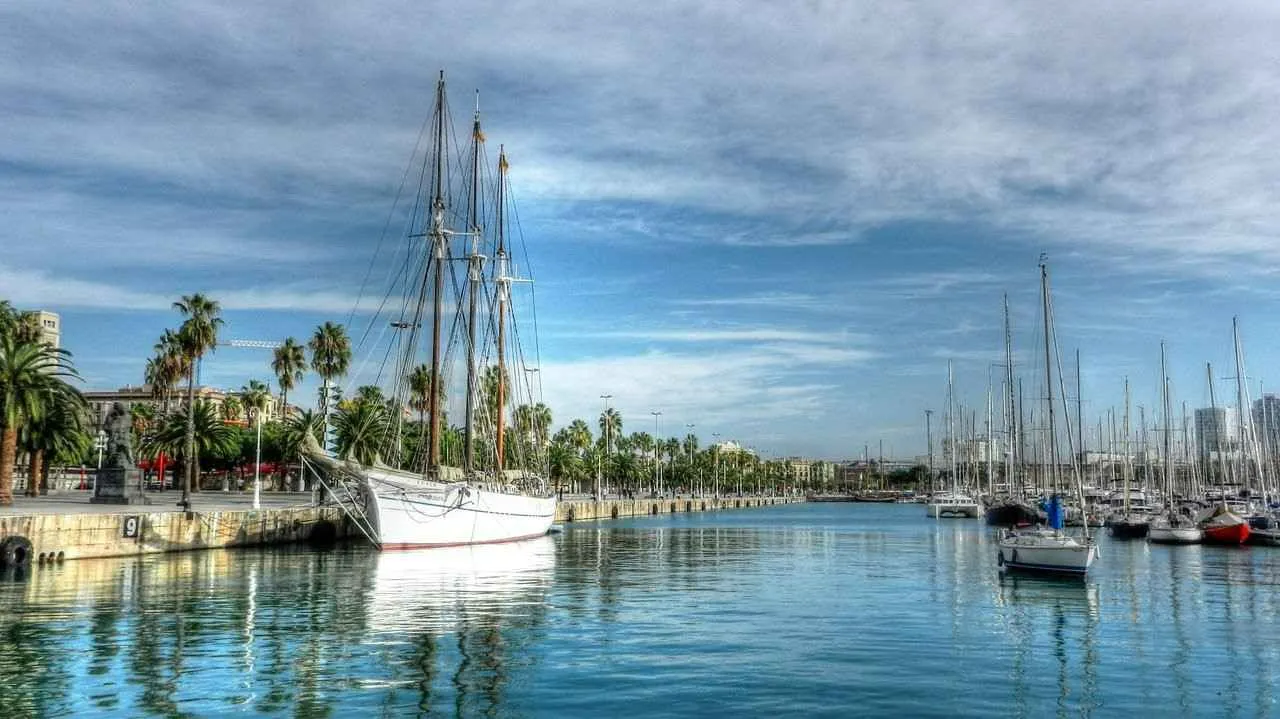
9. Maremàgnum
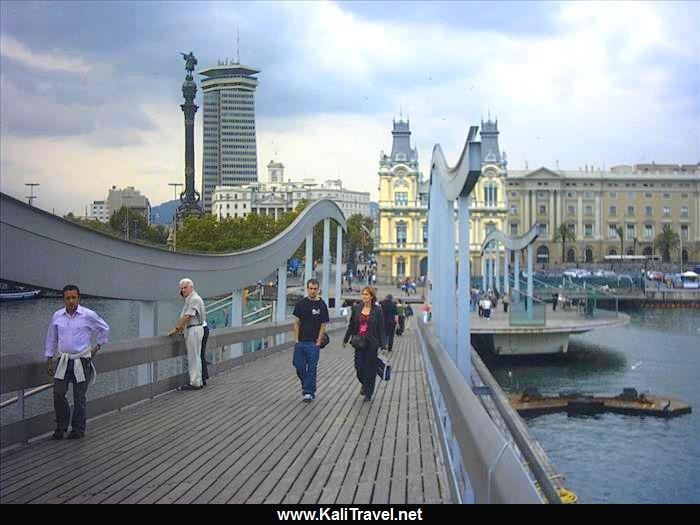
A wooden suspension bridge spans the quayside waters to the city’s Maremàgnum leisure complex. It’s got everything: shops, cinemas, restaurants, night-time bars and pavement cafés set against the incomparable backdrop of the Mediterranean.
A siren blared as we were sauntering across to warn pedestrians that the swing bridge was about to be raised to allow a high mast yacht passage from the leisure harbour out to the open sea.
10. Barcelona Aquarium
One of the highlights on Maremàgnum is the Aquarium Barcelona. The biggest aquarium in Europe takes you on a fascinating journey to the bottom of the ocean – a walk through the glass tunnel beneath the shark pool is a magical moment not to be missed.
11. Barceloneta and Olympic Harbour
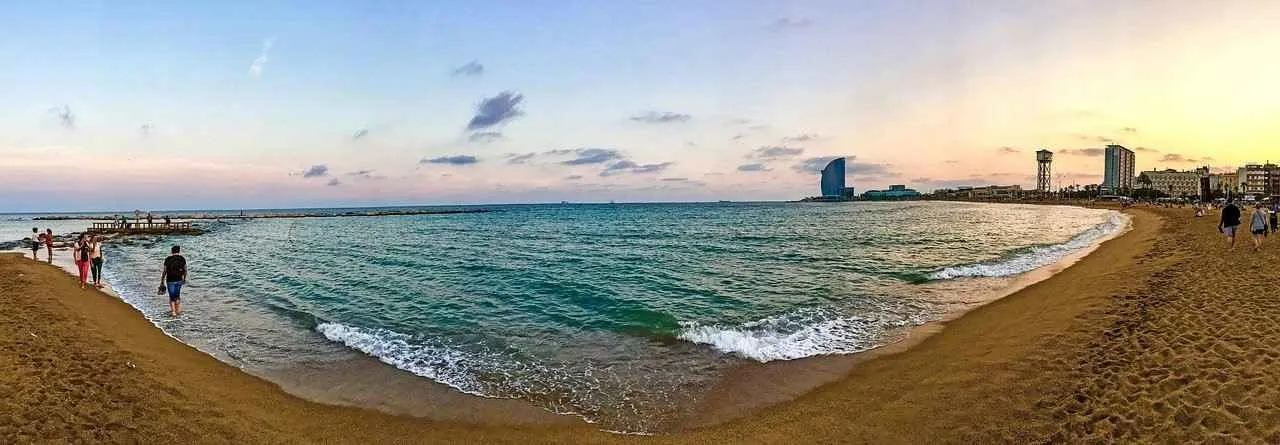
The Barceloneta is a traditional sailing and fishing district which is renowned for its fish and seafood restaurants. The seafront promenade borders over four kilometres of sandy beaches.
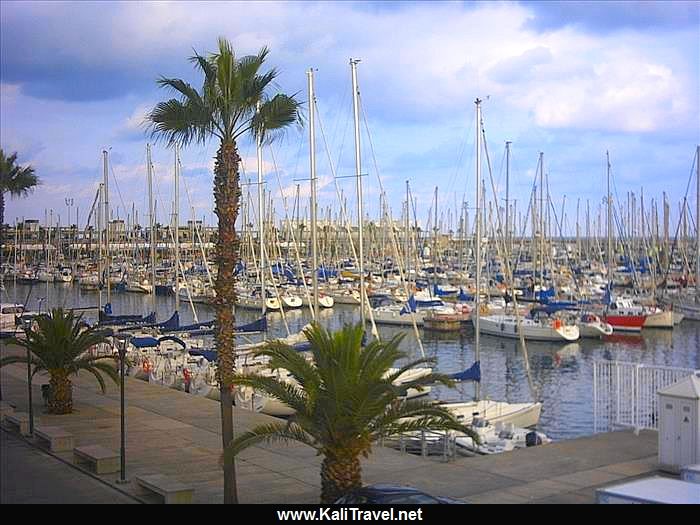
Saunter along to the Olympic Harbour. More than 40 bars and restaurants makes this a top dining and recreational area, where there’s the chance to enjoy all kinds of water sports.
12. Parc de la Ciutadella
Nearby, you will find the Parc de la Ciutadella, one of the city’s biggest parks complete with cascades and sculptures, an artificial lake and ornamental fountain.
The Museum of Natural Science, Barcelona Zoo and the whimsical Castle of the Three Dragons, are located here too.

La Ribera District
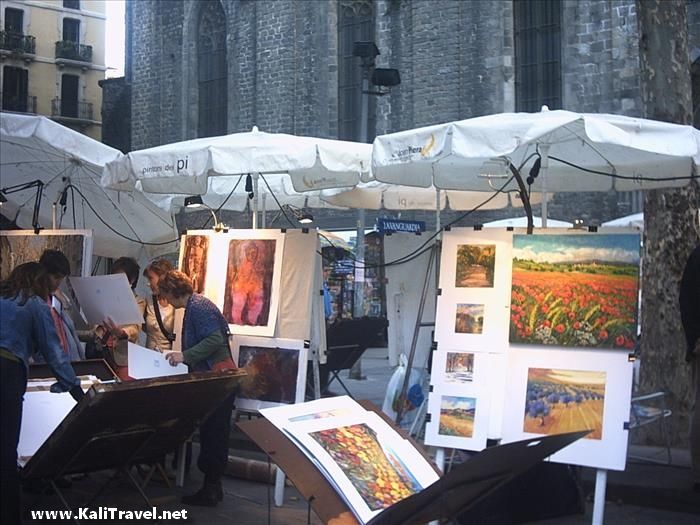
Either walk or catch the bus back to La Ribera district, which was the city’s hub of commerce and seafaring trade in the Middle Ages. Wandering through the historic quarter you can just imagine the atmosphere hundreds of years ago. Narrow streets open onto ancient plazas where local artists set up stalls to display their original paintings.
13. Picasso Museum
The Picasso Museum, one of Barcelona’s most visited museums, and the Palau de la Música Catalana warrant a visit if you have time. Picasso’s museum is located in five adjoining medieval mansions, once the homes of noblemen, on Moncada Street in the heart of La Ribera. This is the best collection of Pablo Picasso’s artworks in the world and includes drawings, illustrations, paintings, engravings and ceramics. Temporary exhibitions and the extensive library are also of great interest.

14. Palau de la Música Catalana
Barcelona’s premier concert hall ‘the Music Palace’ is another prime example of Catalan Modernism style, an early 20th century auditorium inscribed on the UNESCO World Heritage list.
A compendium of iron and reddish brick structure, the exuberant façade and exquisite interior are beautified with sculptures, stained glass panes and skylights, and colourful mosaic tiles. A wide range of musicals, choral music and symphonic performances are regularly held here.
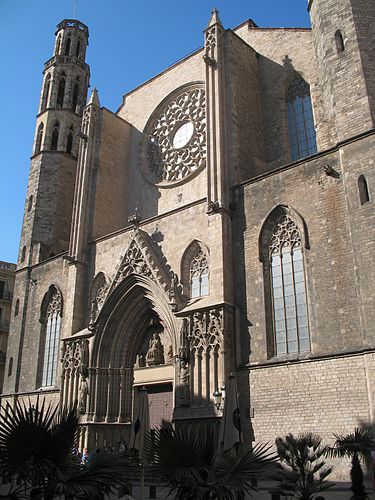
15. Santa Maria del Mar Church
I covertly watched a wedding service being held inside Santa Maria del Mar Basilica, a gothic place of worship consecrated in the 14th century which has inspired some of the best novels about Spain.
This ancient church is one of the top historical sites in Barcelona. The flamboyant rose window on the stark stone exterior, 2 slender bell towers and the arched tracery over the main entranceway are distinguishing features.
Gothic Quarter
16. Plaza del Rei and Palau Reial Mayor

In the afternoon, visit Barcelona Gothic Quarter (Barri Gòtic) where the remains of Barcina, the original Roman city, survive alongside a compendium of medieval buildings.
The Palau Reial Mayor, the grand 14th century palace where the royal family of the Kingdom of Aragon once lived, is located in Plaza del Rei, and is now part of Barcelona City History Museum.
17. St Eulalia Cathedral
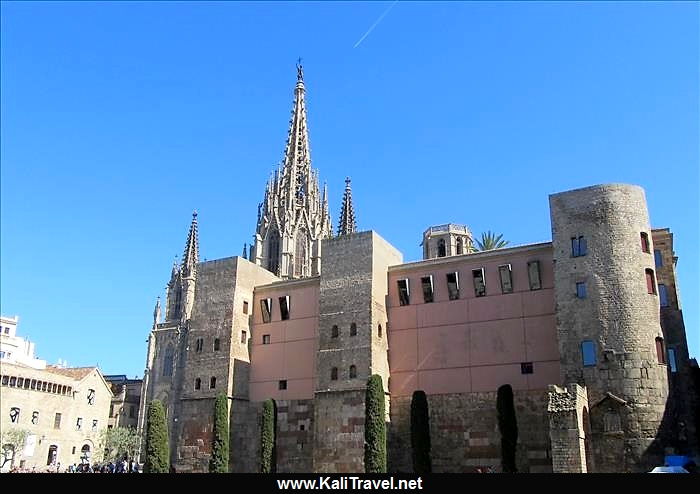
The candle-filled Cathedral of St. Eulalia) (1298) is very atmospheric, especially the cute cloisters where a clutch of 13 white geese swim round the central pond. This is one of the top places to see in Barcelona. https://catedralbcn.org/
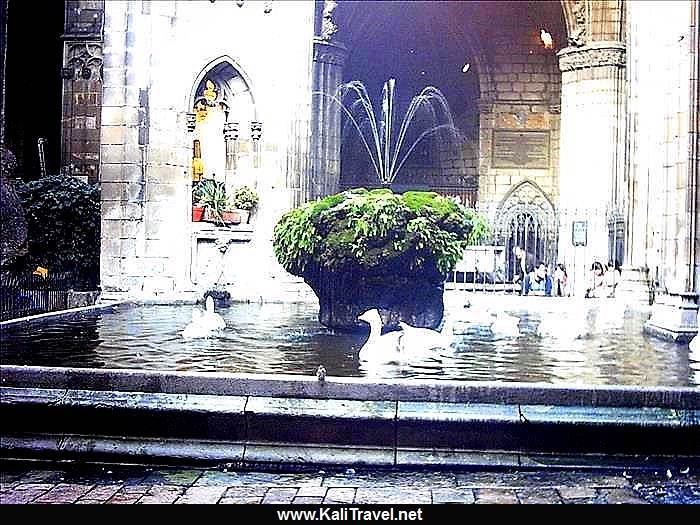
Sunlight filtres though the stained glass windows to highlight the 28 chapels which embellish the vaulted central nave, each with an inner altar where devotees can pay homage to their favourite Saint.
I lit a red candle for good luck and placed it beside the others that adorned San Pancracio’s chapel (St Pancras ensures good health and work I was told). It’s a pity that the traditional wax candles have now been replaced by electrical flickering flames.
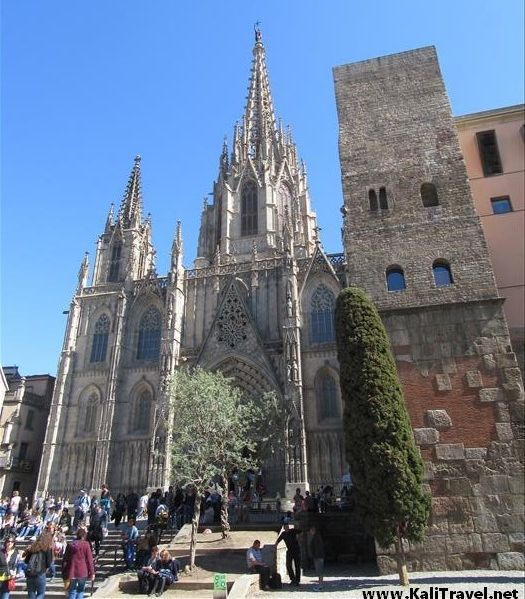
Outside a crowd had gathered to listen to a large band of musicians who were playing their instruments on the steps leading up to the cathedral where people of all ages joined hands and circled around to the music in a traditional dance. We stayed in the plaza for a while, watching the agile impromptu dancers and several amusing street entertainers.
18. Plaça Sant Jaume and Palau de la Generalitat
Plaza Sant Jaume is the very centre of ‘Old Barcelona’, and where the medieval Palau de la Generalitat (the seat of the Catalan government since 1359) stands opposite Barcelona City Hall.
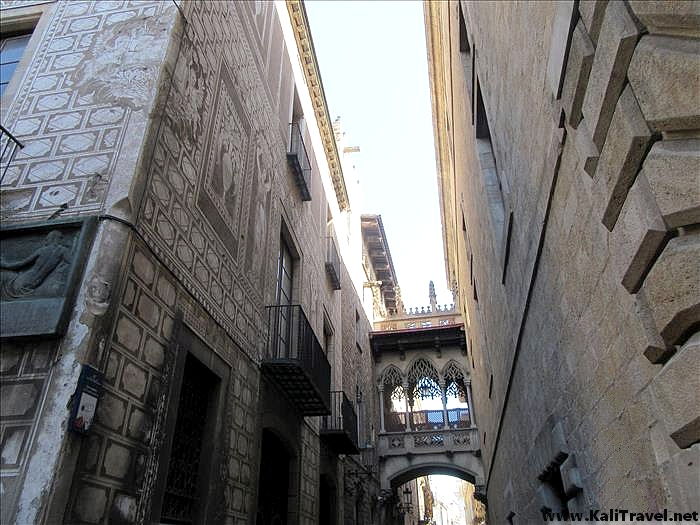
Bishop’s Bridge, the much photographed neo-Gothic corridor which arches over narrow Carrer del Bisbe street, connects the Palau to La Casa dels Canonges, the official residence of the President of Catalunya. The spooky skull carved into the underside of Pont Bisbe has sparked many local legends.
Antique dealers, bookstores, restaurants and curiosity shops, add to the Gothic Quarter’s undeniable historic interest.
El Born District
Sites of particular interest in El Born include the Mercat de Born, once again of Nouveau Art design with a cast iron framework and two distinctive domes. The old market premises have been ingeniously reformed into a cultural centre with a public passageway with views to the Roman ruins below.

Evening in Barcelona
In the evening Juan and I had dinner in this fashionable district – numerous restaurants and cocktail bars have created a lively atmosphere in these backstreets whilst respecting the traditional character of the medieval city centre. Just south of traditional ‘La Ribera’, the ambience here is very international frequented by both expats and tourists enjoying Barcelona’s nightlife.
How to Get to Barcelona
There are excellent rail and road connections to the city which means it’s easy to do day trips from Barcelona to see more of the Catalonia Region. Alternatively, make Barcelona part of a longer holiday plan by including the city in an extended 2 week Europe itinerary.
By Plane
Nearest Airport
Barcelona – El Prat (BCN) https://www.aeropuertobarcelona-elprat.com/ingl/index.html
Barcelona-El Prat airport receives regular international flights from major cities around the world, as well as low cost carriers who mainly operate from European countries. There are 2 passenger terminals which are connected by a free shuttle bus. Conveniently located 12 kilometres from Barcelona city centre, there are several ways to get to the airport.
Airport Transfers
There are a number of easy and economical ways of getting to Barcelona airport.
By Aerobus: takes 35 minutes to reach Plaça Catalunya (one-way fare 5.90€).
By Train: runs from Terminal 2 to Sants Station in 20 minutes (one-way fare 4.20€).
By Metro: the‘orange line’ L9 south (sud) goes from T1 and T 2 to the University Area taking around 35 minutes (one-way fare 5.15€). Change at Torassa Station to ‘red line’ L1 for Plaça d’Espanya and Plaça Catalunya. See all the lines on this map of Barcelona Metro.
By Nitbus: operates throughout the night, connecting the airport to Plaça Catalunya and Plaça d’Espanya. Line 18 goes to Terminals 1 and 2, the journey takes around 40 minutes (one-way fare 2.20€).
Car Rental and Taxis are available from both terminals. Preferably, book in advance.
Getting to Barcelona by Rail
Barcelona Sants is the major railway station in the city, where the international lines, high-speed trains from around Spain, and regional services arrive. The AVE takes 2 hours 30 minutes to reach Madrid, for example, or 6 hours to Paris (AVE-TGV).
Getting to Barcelona by Road
The A7 Mediterranean motorway runs northwards to Girona and on to the French border, 150 km away; and southwards to the regions of Valencia, Murcia and Andalusia; the A2 motorway goes up to Zaragoza, and links to Madrid or Bilbao.
Getting to Barcelona by Sea
Barcelona is the biggest cruise liner port in the Mediterranean. There are also three ferry terminals with routes to the Balearic Islands, Italy and North Africa (Tangiers). Those arriving by private boat have a choice of 16 marinas along Barcelona coastline.
Related Posts on Barcelona
What to See in Montjuïc – Barcelona 3 Day City Guide
On our third day in Barcelona, I took time out to discover some of the interesting sights further away from the city centre. You’ll definitely want to see Montjuïc – Barcelona in 3 days is rather hectic to see but with a little planning it’s easy to do.
Read more…
Road Trip Costa Brava – 3 Day Itinerary From Barcelona
Enjoy a road trip along the Costa Brava. This 3-day itinerary from Barcelona is packed with suggestions for activities, places to see and must-have experiences.
Our Popular Guides to Spain
A guide to Exploring Málaga – sun, sea and history on Spain’s Costa del Sol.
There are so many things to do in Málaga (Spain), lots of history, great food and beaches.
Ultimate Granada Guide – What to See in 3 Days
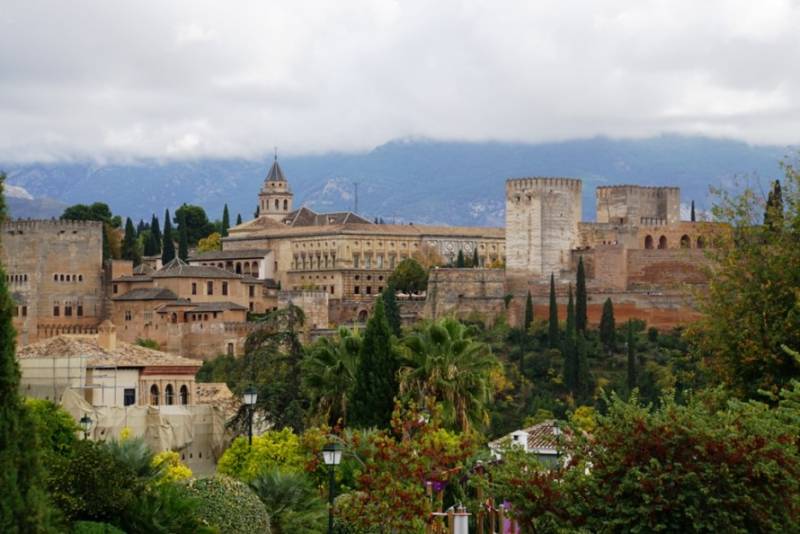
Visiting Spain and only 3 days to see Granada?
Our ultimate Granada guide explains how to see the historical city sites, and the top things to see and do.
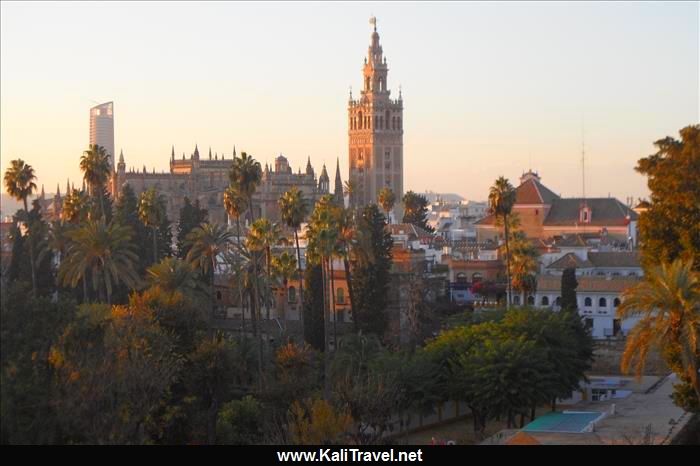
A 2 day guide to seeing the sites of Seville.
The panoramic view from our bedroom terrace at Hotel Alcázar was stunning – Seville skyline was backlit by the sunset, the unmistakable Giralda tower and a dozen church spires piercing the sky.
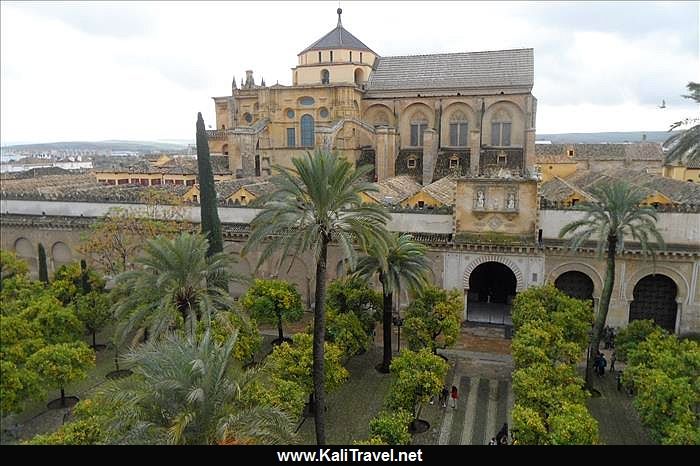
Discover Córdoba – the Spanish city with a 1000 ancient archways.
Córdoba sits beside the legendary River Guadalquivir in the heart of Andalucía, in southern Spain. Here’s our rough guide of what to see in 2 days.
Vitoria-Gasteiz in the Basque Country
Visit Vitoria-Gasteiz capital of the Basque Country in northern Spain, walk through the old town to see the historical sites, admire original street art, eat the best pintxos, join in the festivities and find out what to do there in our insider guide.
Travel Guide to Costa Blanca in Spain
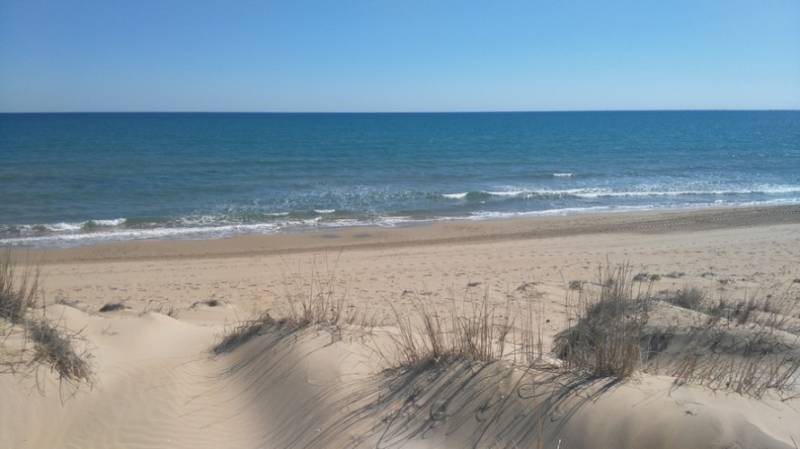
My ‘insider’ travel guide to Alicante and the Costa Blanca. The Costa Blanca is a famous stretch of coast in southeastern Spain, where a warm Mediterranean Sea bathes white sand beaches and pebble bays encircled by distant mountain peaks.
Canary Islands Guide And Travel Advice
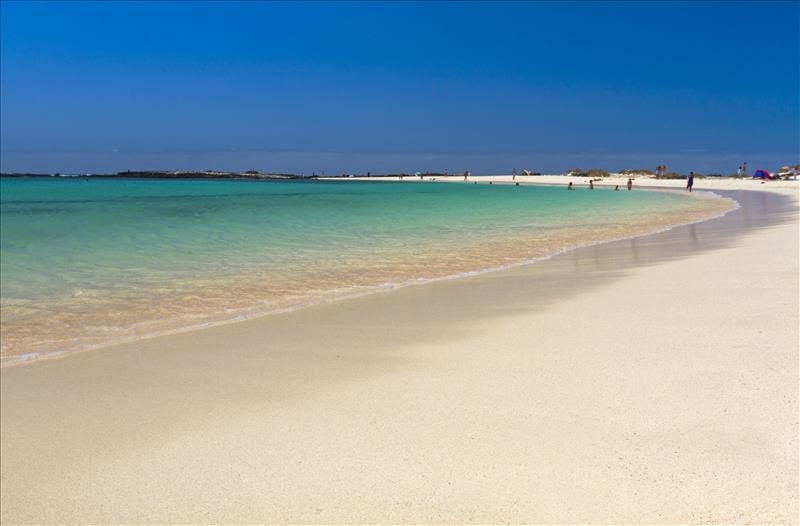
Updated Travel Guide with everything you need to know about Spain’s Canary Islands.
The latest advice on what to see and do, best beaches and nature activities, how to get there and inter-island transport…
Discover the World with![]() the blog with a focus on independent travel
the blog with a focus on independent travel




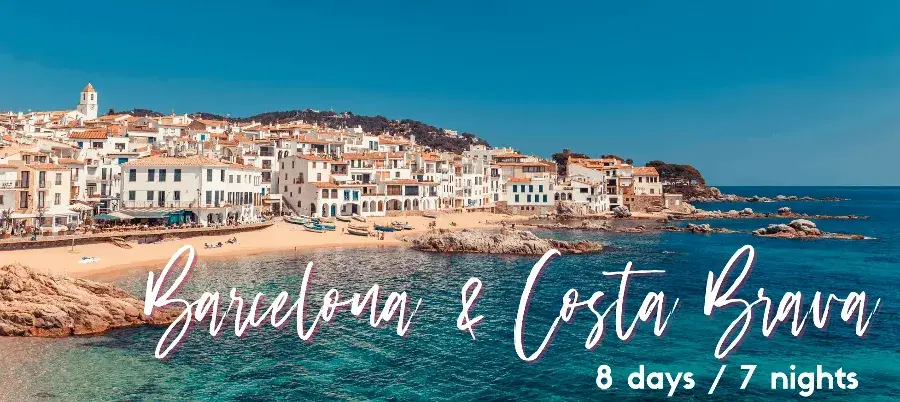
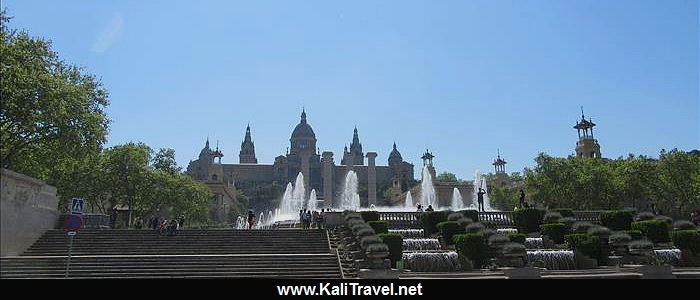
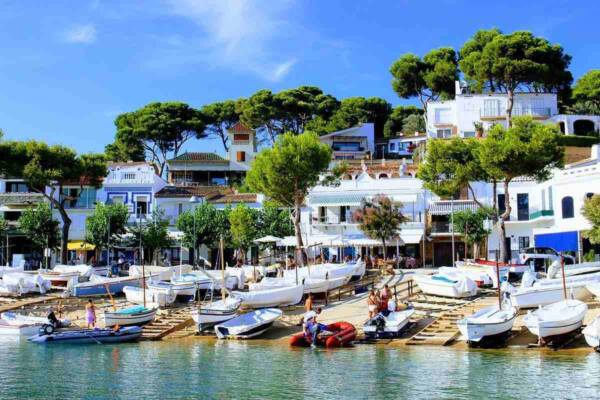
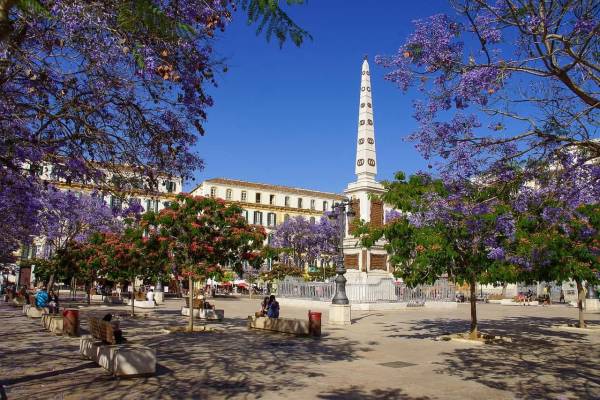
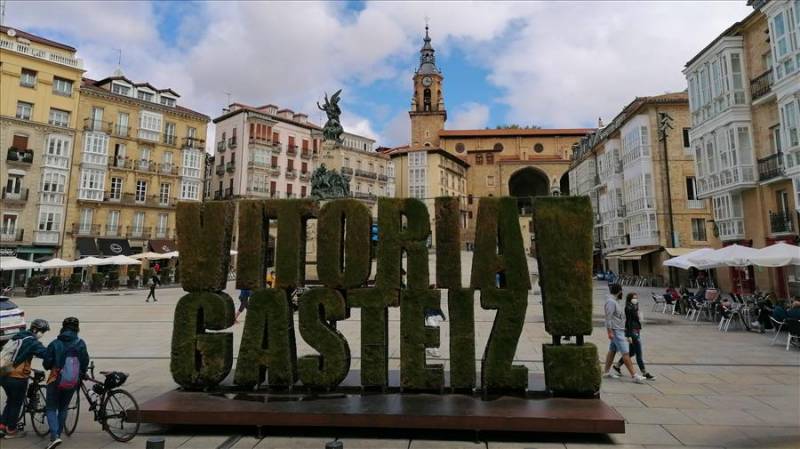
I enjoyed Barcelona when I visited and stayed in the Gothic Quarter. I didn’t see everything on this list so I know I need to go back. It’s fun to see the highlights of a city, but Spain is definitely a place where you should slow down and enjoy life happening around you like the wedding, musicians and dancing you stopped to admire.
Nice guide to this beautiful city! Brings back memories of when I visited Barcelona and instantly fell in love with it!
Fantastic guide we are hoping to get there next summer as our previous trip was cancelled. The Gothic corner looks great and would love to see that amongst many of the other sites
I only had 2 days in Barcelona, and you did so much more than I did! This is a great itinerary and fabulous for anyone wanting to feel the vibes of an incredible city!
I would love to spend two days (or more) in Barcelona. This is an awesome guide to create the perfect itinerary. Beautiful pics!
Hi thank you for this guide. As we are eyeing Barcelona for next year! I’m not sure we will be able to visit all these sites. But I’m so looking forward for this trip.
What a great jam-packed two day itinerary for Barcelona. If we’re short on time, we take the tourist bus. Always so easy to see the sites, especially with young kids. I adore everything about Barcelona and can’t wait to return when we can travel again.